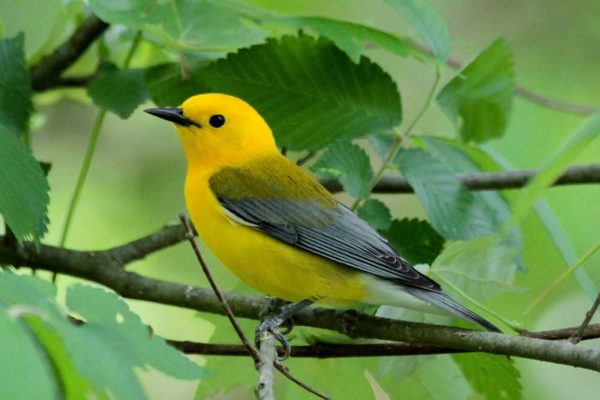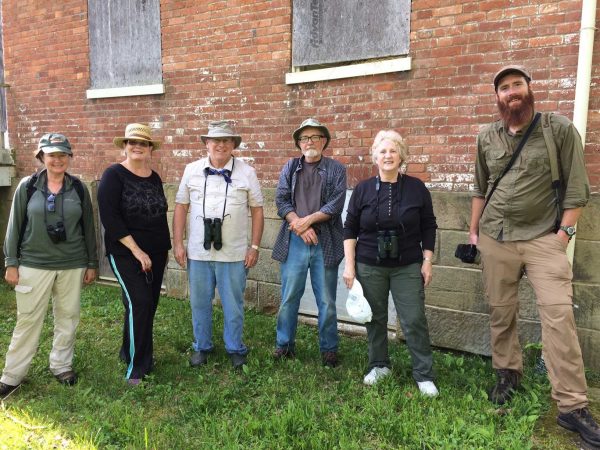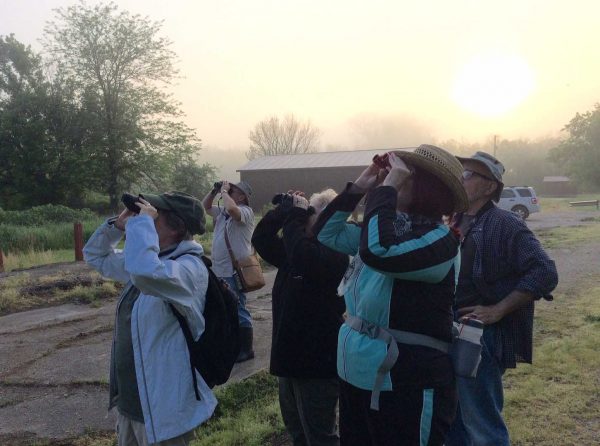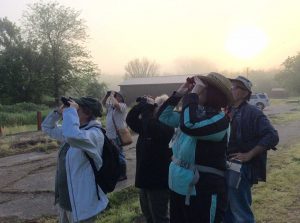- Like
- Digg
- Del
- Tumblr
- VKontakte
- Buffer
- Love This
- Odnoklassniki
- Meneame
- Blogger
- Amazon
- Yahoo Mail
- Gmail
- AOL
- Newsvine
- HackerNews
- Evernote
- MySpace
- Mail.ru
- Viadeo
- Line
- Comments
- Yummly
- SMS
- Viber
- Telegram
- Subscribe
- Skype
- Facebook Messenger
- Kakao
- LiveJournal
- Yammer
- Edgar
- Fintel
- Mix
- Instapaper
- Copy Link
On April 30, as part of OVEC’s 30th Birthday Bash Weekend, Mike Griffith and I agreed to lead a bird walk at the Green Bottom Wildlife Management Area (WMA).
Six wonderful, bird-loving, nature-loving folks (above and below; photos by Janet Keating) joined us for our Sunday-morning trip. Stretching along the banks of the Ohio River, Green Bottom WMA is a network of agricultural lands, forestlands, wetlands, and open water. More than 100 species of birds may be seen here each year. These unique wetlands are located just 16 miles north of Huntington. In fewer than the 5 hours scheduled for the outing, we saw 53 different species.
While homing in on a green heron on the gravel road that leads to the boardwalk, we spotted a killdeer, with three fluffy, tiny chicks, darting back and forth on the gravel road. When killdeer hatch, they are able to walk on the ground and feed themselves immediately; they are referred to as being precocial, as opposed to altricial. Altricial birds are hatched featherless and unable to feed themselves for several weeks or even months. We watched as the parent bird (likely the mother, though both species care for the nest and young), gave her “broken wing” display to distract us away from her little ones. These hatchlings were likely no more than two days old and will not be flying for several weeks.
After walking the road between the two major wetlands, as well as the boardwalk, we drove to the General Jenkins house (a well-preserved brick house of a Civil War general, built in 1853) in search of a Baltimore oriole. As we first pulled in, as if on cue, we saw a mature male oriole perching atop a bare tree, singing its heart out. Almost all of us saw it, but Mike knew that this bird reliably can be found in one of the large sycamore trees next to the house, so he walked in that direction. Soon, a lovely first-year male (bright yellow and black instead of orange and black) appeared for all to see. It flew to various places on lower tree limbs and even landed on the ground, giving us excellent views. A few minutes later, the mature male joined this younger bird.
Toward the end of our walk, though some of our group needed to head back home, Brodie, son of OVEC members Ken and Barb Lewis, wanted to see a prothonotary warbler, a stunner of a warbler that would be a life bird (his first sighting) for him. This warbler reaches the northern limits of its range in West Virginia and prefers nesting in tree cavities near water. Brodie, who’s been birding since 2011 in Asia and in the northwest United States, hasn’t seen all of the West Virginia species. I am always thrilled to show someone a life bird!
In order to see this specialized warbler, we left the main wetlands and drove a couple of miles up Route 2 to an oxbow area of Green Bottom WMA. We hiked briefly down a grassy area to a creek and backwater. Mike and I had seen this bird here just a few days before. Then, we waited. And waited. And waited. Brodie could hear it calling in the distance, but we really wanted him to see this beauty. Just as we were about to give up, a small, bright, mostly yellow-gold bird flew low across the water and then landed in the nearby tree. It was the prothonotary warbler! Brodie, equipped with a camera and zoom lens, began photographing as the bird perched ever closer. Click, click, click went the camera. Brodie had the time of his life connecting with this warbler—a truly memorable nature experience. We see a magazine cover in Brodie’s (and the bird’s) future!













Wow looks like you all had a lot of fun, It’s also really amazing that you got to see a whopping 53 species of birds in the space of 5 hours. Being the bird and nature lover that I am, I can not deny the fact that I am so jealous of all the fun you had. I need to plan one with my friends soon, if you don’t mind can you suggest the best binocular brand? Thanks a mill!
Hi Nathan.
We had a great time birding. 53 species is good number for a brief morning walk, especially for novices like the majority on this walk. We took our time so everyone could get a good look at some birds they have never seen. I’ve found that plenty of folks have never seen many of the migratory species that we found. At any rate, it’s a joy to be with someone who is seeing a bird for the first time.
Regarding your question about binocular recommendations. I recommend that you spend some time on-line reading reviews,
etc. If you are a novice birder, you may want to begin with 7 x 25 or no larger than 8 x 42. Until a person develops some skill locating and focusing, either of these sizes are a bit easier to use. Even after nearly 40 years birding, I prefer 8 x 42. Price, for most folks, is also a consideration. The range is broad. Of course good optics is most important. Nowadays one can find reasonably priced binoculars that have very good optics along with other features. I’m happy with my Nikon Monarch binoculars— 8 x 42. I’ve had them several years and I understand they have a newer model now. They are reasonably priced and really good in low light conditions. I also would suggest that you go to a store and try various ones to find the best choice for you.
Since you’re with a binocular company, I would imagine that you have the inside scoop! My birding buddies use different brands—Swarovski, Leica, Zeiss and Nikon.
Good luck and good birding!
Janet